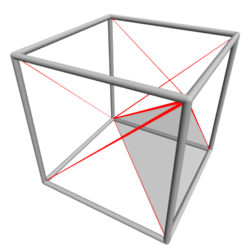Marching tetrahedra

Marching tetrahedra is an algorithm in the field of computer graphics to render implicit surfaces. It clarifies a minor ambiguity problem of the marching cubes algorithm with some cube configurations. It was originally introduced in 1991.[1]
Since more than 20 years have passed from the patent filing date of the marching cubes (June 5, 1985), the original algorithm can be used freely again, adding only the minor modification to circumvent the aforementioned ambiguity in some configurations.
In marching tetrahedra, each cube is split into six irregular tetrahedra by cutting the cube in half three times, cutting diagonally through each of the three pairs of opposing faces. In this way, the tetrahedra all share one of the main diagonals of the cube. Instead of the twelve edges of the cube, we now have nineteen edges: the original twelve, six face diagonals, and the main diagonal. Just like in marching cubes, the intersections of these edges with the isosurface are approximated by linearly interpolating the values at the grid points.
Adjacent cubes share all edges in the connecting face, including the same diagonal. This is an important property to prevent cracks in the rendered surface, because interpolation of the two distinct diagonals of a face usually gives slightly different intersection points. An added benefit is that up to five computed intersection points can be reused when handling the neighbor cube. This includes the computed surface normals and other graphics attributes at the intersection points.
Each tetrahedron has sixteen possible configurations, falling into three classes: no intersection, intersection in one triangle and intersection in two (adjacent) triangles. It is straightforward to enumerate all sixteen configurations and map them to vertex index lists defining the appropriate triangle strips.
Comparison with marching cubes
Marching tetrahedra computes up to nineteen edge intersections per cube, where marching cubes only requires twelve. Only one of these intersections cannot be shared with an adjacent cube (the one on the main diagonal), but sharing on all faces of the cube complicates the algorithm and increases memory requirements considerably. On the other hand, the additional intersections provide for a slightly better sampling resolution.
The number of configurations, determining the size of the commonly used lookup tables, is much smaller, since only four rather than eight separate vertices are involved per tetrahedron. There are six tetrahedra to process instead of one single cube. The process is unambiguous, so no additional ambiguity handling is necessary.
The downside is that the tessellation of a cube with tetrahedra requires a choice regarding the orientation of the tetrahedra, which may produce artificial "bumps" in the isosurface because of interpolation along the face diagonals.[2]
See also
References
- ↑ Akio Doi, Akio Koide. "An Efficient Method of Triangulating Equi-Valued Surfaces by Using Tetrahedral Cells." IEICE Transactions of Information and Systems, Vol.E74-D No. 1, 1991
- ↑ Charles D. Hansen; Chris R. Johnson (2004). Visualization Handbook. Academic Press. pp. 9–11. ISBN 978-0-12-387582-2.
External links
- Visualization of Implicit Surfaces Using Adaptive Tetrahedrizations (Heinrich Muller, Michael Wehle)